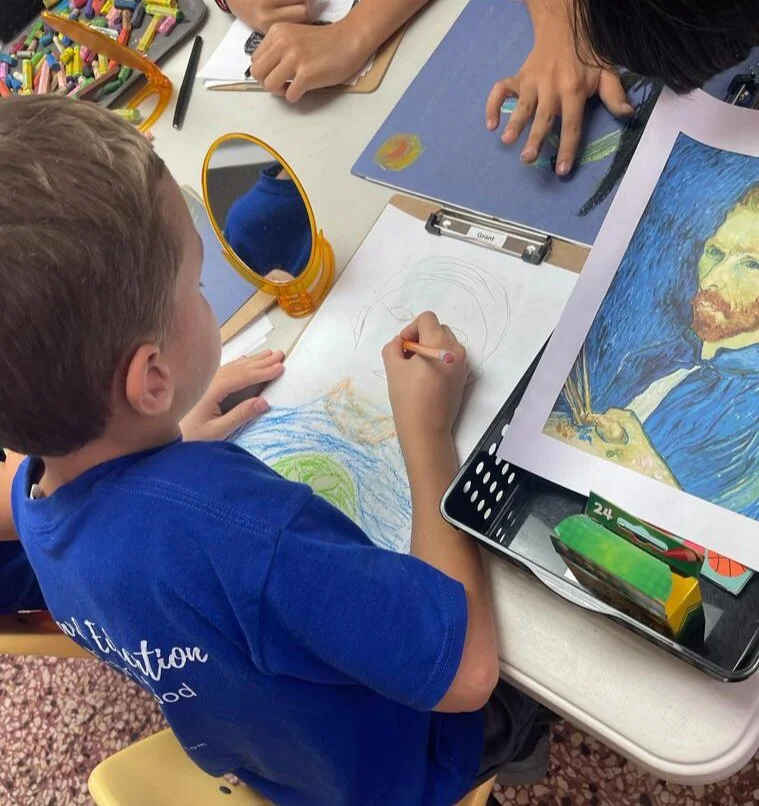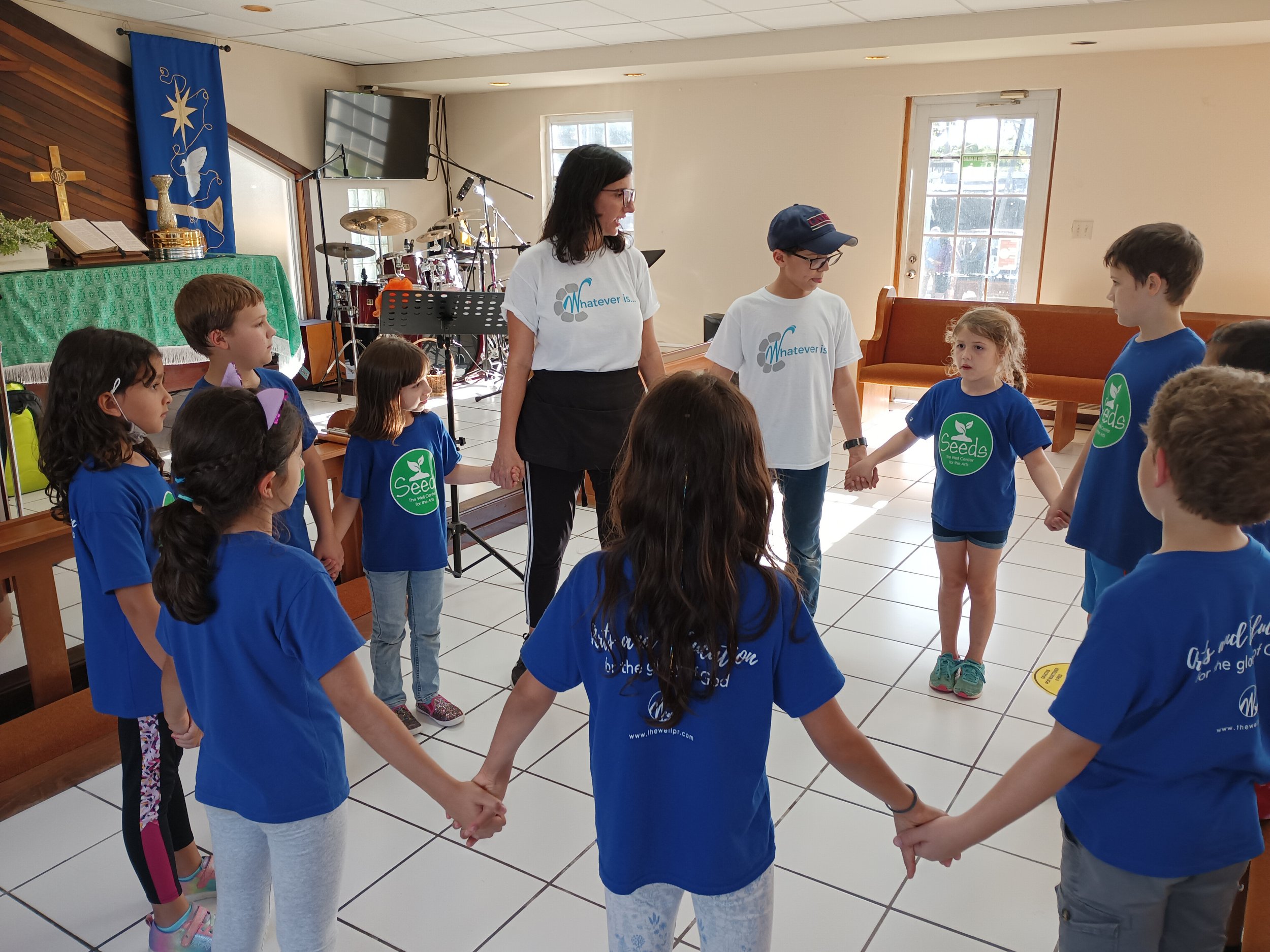Week 19: Get Ready for Your Closeup
WEEK 19: Get Ready for Your Closeup
The Seeds students had the opportunity to display some of their self-portraits from last week, in addition to celebrating a birthday with an inflatable photo frame. This fun activity seemed to preview the excitement of our upcoming “Family Day and More” event that the OAKS students are organizing. And speaking of closeups, the Drama clubs from our Arts Academy also began this week! Read below for more details.
Scroll down to see the supplemental readings for the week, galleries of our latest photos, and our current memory verse.
Memory Verse #9
“Therefore, I urge you, brothers, in view of God’s mercy, to offer your bodies as living sacrifices, holy and pleasing to God—this is your spiritual act of worship. Do not conform any longer to the pattern of this world, but be transformed by the renewing of your mind. Then you will be able to test and approve what God’s will is—his good, pleasing and perfect will.”
SEEDS and OAKS Programs Suggested Readings for the Week
The readings are meant to reinforce the topics covered in class last week and to have parents and other siblings be a part of what we’re learning. These readings are not required for the class, but can be a good supplement. You can try to read all or just a few of the selections. Use your discretion as to what to cover based upon the ages of your children.
HISTORY
The Last 500 Years / World History from Ancient to Modern Times
P.70-71 / p.266-267
There are some great Internet Quicklinks to access that go along with the topics from these pages.
The Story of the World
The Mexican Revolution p. 249
World War I p. 255
GARDEN - Pre-K and K
This week we continued the stories through the life of Jesus. It was our second week implementing a new format for our worship time: we introduce the story on Tuesday and then review the story on Thursday. Then, the girls have an opportunity to draw the part of the story that they like or want to remember the most. It is a sweet time of reflecting and meditating on God’s Word. This week they studied Jesus' baptism by John at the Jordan River.
The girls were excited to finally be able to do some sowing in the garden. When Hallel first saw the new flowers that the Seeds students had planted, she was so happy!! They began by transferring some flowers into new pots and then moved forward to plant two papaya trees by the fence near the stage. As they worked they commented: “I’m so glad we are doing this!” and “it feels good to garden.” They joyfully watered all the newly planted flowers throughout the week.
Inside, we worked with the letter of the week, letter “Nn.” The girls were mindful not to confuse “Mm” with “Nn” and noticed that lowercase “n” has “one hump" instead of two like “m.” Our time at the kitchen and working with blocks seemed too short for the girls so I promised that we would have more time to play with these fun activities this upcoming week.
SEEDS - Grades 1-6
Worship
We were very blessed to celebrate two birthdays this week: that of Lucca and that of our volunteer Marlena. We had a great time giving thanks for the yummy snacks we enjoyed and for the storytime we had, reading Lucca’s birthday book, “Tiny Cedric” by Sally Lloyd-Jones. We focused this week on learning our 9th Memory Verse of the year from Romans 12:1-2. (See above) Check out all the pictures in the gallery below.
Science
How can you not love rubber bands and tennis balls flying around during class??
A rubber band is a great way to show the difference between two main types energy, kinetic and potential. When a rubber band is stretched out, ready to fly off your finger, it has potential energy, stored energy. When you let it fly, it has kinetic energy, energy in motion.
By placing a tennis ball on top of a basketball, making sure that they were touching, and then dropping them together, we got to see how objects with more mass have more energy at a given speed. The energy from the larger ball was transferred to the smaller ball, making it bounce higher than if you dropped the tennis ball by itself. This demonstration also showed the law of conservation of energy, energy can neither be created nor destroyed. It can, however, be transferred.
After distinguishing between kinetic and potential energy, we took time to explore forms of potential energy. Most potential energy exists as chemical energy, atoms and molecules that are ready to be used as fuel. Fossil fuels, especially the ones created when the worldwide Flood described in Genesis covered billions of plants and animals with layers of mud, are a great source of fuel. When these fossils got converted into different forms of stored energy, we had oil reservoirs and natural gas deep in the earth, as well as coal deep inside caves and caverns. These three fuels eventually were extracted and used to fuel our homes, cities, and cars, and as regular household items like crayons, eyeglasses, deodorant, and so much more. Next time you flip a light switch, you can thank God for the Flood!
History
We covered a lot of ground this week…literally! Our study of History began with the Mexican Revolution and then took us all the way to the conflicts in the Balkan Peninsula that ignited World War I. Once again, war began as a result of border and land disputes, as well as long-harbored hatred for peoples of other regions. Using some of the wooden figures we usually use to tell our worship stories, we demonstrated how each country sought bigger and more powerful allies in the escalation of The Great War. Next week, we will get into the U.S.’s involvement in the events that led up to that. In the meantime, check out the Mighty Lions go to battle in the video.
Studio
We forgot to include some of the great self-portraits and Van Gogh inspired artwork from last week. Enjoy the gallery below!







This week, learning about composer John Philip Sousa had us marching all over the place! Sousa is known as “The March King” because although he wrote many different kinds of music, he is most famous for his marches. His song “Stars and Stripes Forever' is the National March of the United States and is played in presidential inaugurations and many other major events. We learned about a very interesting instrument called a sousaphone which is a version of a tuba that fits around the musician, making it easier to march and play at the same time. We saw the instrument in action in a video of a marching band in a fourth of July parade. Then, I taught the students some basic marching band steps and commands. We had a wonderful time in the parking lot outside trying to “walk in step” with each other as we had seen the young people in the video do so masterfully.The kids thought about how hard it must be to march and play at the same time! Finally, they loved to hear that Mr. Jared had been in a marching band when he was in high school.
OAKS - 7+
Worship/Studio
We were so excited to get such great feedback from our very first OAKS podcast last week. We continued in our reading from “A Young Person’s Guide to Knowing God” in order to begin brainstorming for Episode 2.
What we did spend a lot of time this week was on brainstorming ideas for fundraisers we could do to help Esteban reach his goal on Go Fund Me. If your’e not familiar with his story, click here:
https://gofund.me/6c787548
So one of the things we began to plan out was a “Family Day and More” activity that we will be holding on February 25. The students enjoyed working with the program Canva to learn how to design a flyer. Check out their work, and SAVE THE DATE!
History
The Oaks students got a little deeper this week into our study of the Mexican Revolution which then took us all the way to the conflicts in the Balkan Peninsula that ignited World War I. For Mexico, the independance achieved from Spain, didn’t guarantee leadership that would put the best interests of ALL the people first. 50 years of conflict ensued because of this. Over in Europe, war began once again as a result of border and land disputes, as well as long-harbored hatred for peoples of other regions. Our slide presentation demonstrated how each country sought bigger and more powerful allies in the escalation of The Great War. Next week, we will get into the U.S.’s involvement in the events that led up to that.
Science
Is it kinetic or potential energy? That was the question on Tuesday as we began to learn about the two types of energy. We learned that kinetic energy is energy in motion whereas potential energy is energy that is stored up and ready to be used. Having discussed the types of energy, the students had some reading homework about the different forms of energy. On Thursday, we discussed the energy found in fossil fuels. How amazing to learn that God provided for our energy needs through the Flood.The students were particularly interested in the process of finding oil and how costly it is to drill into a hole that turns out to be a “dry hole.” I used a ziploc bag and straws to demonstrate the two different ways oil is taken out of the Earth. We also got a kick out of the basket and tennis ball demonstration and enjoyed avoiding getting hit by the tennis ball in the room!
Arts Academy
Check out some photos from the drama clubs that began this week. We are leading up to a final stage production of Charlotte’s Web in April! More info on that coming soon.







































































